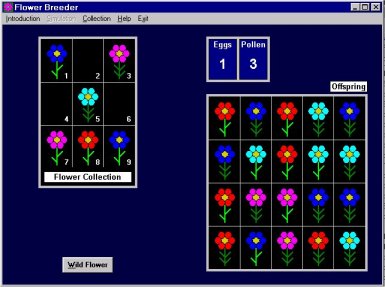|
Biology Dept Kenyon College |
|
Biology Dept Kenyon College |
|
1. Explain how cell division differs between bacteria and eukaryotic
cells.
The simplest possibility is incomplete dominance. If you cross the peacock with India Blue peahens, half their offspring will be straight India Blue and half will be mixed (a few white feathers). This may be hard to tell in the hens, however, as the white feathers would be less noticeable. But if you do find a mixed peahen, and breed it with a mixed peacock, 1/4 of offspring will be pure white. 3. (corrected) In Flowers, explain the inheritance pattern of
all flower petal colors. How can a cross between a pink
flower and a blue flower produce
four different colors? 
To get the cross to work, it helps to first
cross Blue with Orange, and Pink with Orange. Then you know that
all the Blue and Pink offspring each are "hiding" an orange allele.
4. The phenotype of fused finger joints is dominant, yet the trait occurs
in children whose parents are both normal. How can this be explained?
Upon testing, suppose one of the parents turns out to have fused toes.
How can this be explained? 5. What is the "histone code"? How might the histone code be involved in the phenomenon of question 4? The histone code involves chemical modifications
to DNA-associated histones (or to DNA itself, as in the case of methylation.)
Acetylation of histone usually turns a gene on (enables transcription
to make messenger RNA). Methylation of histone (or of DNA itself) usually
turns a gene off. Phosphorylation may either enhance or repress gene
expression. Histone modifications might differ between individuals who
share the same allele sequence, such as the allele associated with an
extra finger. It is possible that the penetrance or expressivity of
an allele could be affected by histone modification. |